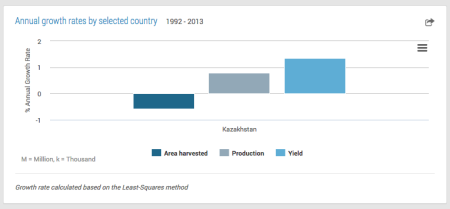https://twitter.com/GrantBrooke/status/603892676249915394
My sentiments exactly. This is the kind of thing that keeps nutritious, locally-important, traditional crops underused. Quite apart from messing with the livelihoods of farmers.
Agrobiodiversity is crops, livestock, foodways, microbes, pollinators, wild relatives …
https://twitter.com/GrantBrooke/status/603892676249915394
My sentiments exactly. This is the kind of thing that keeps nutritious, locally-important, traditional crops underused. Quite apart from messing with the livelihoods of farmers.
![]() Staff of India’s National Bureau of Plant Genetic Resources (NBPGR) recently published a very thorough analysis of the state of conservation of Indian crop diversity outside India. 1 One of the take-home messages was as follows. Yes, India has not yet formally declared what material “under its management and control” (which in the jargon means basically the National Bureau of Plant Genetic Resources) is in the Multilateral System of the Plant Treaty. But the fact is that a lot of Indian material is already in it, via other genebanks, largely (though not exclusively) the international collections managed by the CGIAR centres. And also in Svalbard.
Staff of India’s National Bureau of Plant Genetic Resources (NBPGR) recently published a very thorough analysis of the state of conservation of Indian crop diversity outside India. 1 One of the take-home messages was as follows. Yes, India has not yet formally declared what material “under its management and control” (which in the jargon means basically the National Bureau of Plant Genetic Resources) is in the Multilateral System of the Plant Treaty. But the fact is that a lot of Indian material is already in it, via other genebanks, largely (though not exclusively) the international collections managed by the CGIAR centres. And also in Svalbard.
That’s fair enough. But it’s only half the story, as the authors themselves readily admit:
This analysis does not attempt, in any manner, to undermine the significance of the exotic germplasm material received by India during the course of time, irrespective of the source. India is a recipient of a large amount of germplasm over the period of time from multiple donors including CG genebanks and other national genebanks.
Fortunately, we have data on both sides of the equation. Among the papers in support of next week’s third meeting of the Plant Treaty’s Ad Hoc Open-ended Working Group to Enhance the Functioning of the Multilateral System of Access and Benefit-sharing (sic) may be found “Twenty five years of international exchanges of plant genetic resources facilitated by the CGIAR genebanks: a case study on international interdependence,” a contribution from Bioversity. That includes the following table listing the 25 top countries providing germplasm to, and receiving germplasm from, the CGIAR centres over the period 1985-2009.
So India has contributed significantly to germplasm flows over the years — and also benefitted significantly. As has every other country on earth, I’m willing to bet. No getting around the fact that we’re all massively interdependent for crop diversity. (Stay tuned for more on that, there’s something in the works from our friend Colin Khoury that will approach the problem of quantifying interdependence from another angle…) Which is not to say that the functioning of the benefit-sharing side of the system cannot be improved upon. 2 And that of course is the task of the aforementioned Ad Hoc Open-ended Working Group, and we wish them luck with the last round of deliberations that have been going on for over a year now. If you want to get an idea of which way their thinking is going, you could start with the draft of the resolution they would like the Governing Body of the Treaty to consider passing at their next big meeting in October.
We’re great fans here of featuring maps of the distribution of different crops around the world. You may have noticed that. And, perhaps inevitably, when we do, we more often than not succumb to the temptation of making some comment or other about the ecogeographic limits of said distribution. It’s rare, however, that we get to ground-truth our observations. So imagine my joy when the following tweet appeared a few days back:
Once were rice paddies on arid land close to Aral Sea boundaries: tremendous helicopter flight over region. @UNDPKAZ pic.twitter.com/AQtXQHlObc
— Helen Clark (@HelenClarkNZ) May 24, 2015
Because we had commented some years ago on rice cultivation in Kazakhstan, in particular how it seems to be hanging on just on the edge of the northern limit of the crop. Well, as the photo in the tweet suggests, maybe “hanging on” is too strong a phrase, though being at the northern limit of its range is perhaps not the main reason for that, at least around the Aral Sea. Although FAOStat records an overall decrease in area harvested since 1992, yields do seem to be holding up.

Incidentally, Genesys knows of almost 300 accessions from Kazakhstan, mainly, but not entirely, from VIR. I’m reliably informed material from Kazakhstan is among the most cold tolerant in the world, which you’d probably expect.
Over the years, we’ve mentioned attempts by breeders to call an evolutionary do-over and re-synthesize interspecific hybrid crops like bread wheat, banana, brassicas and peanuts. I don’t think we mentioned an early attempt to do something similar with potato which ended up not quite working to plan. Anyway, point is, they’re going to try it with coffee now, according to Dr Timothy Schilling, executive director of World Coffee Research (WCR):
What we aim to do is to get a bunch of highly diverse C eugenioides and C canephora 3 and cross them, to recreate C arabica but better — more diverse.
I for one would like to taste it.